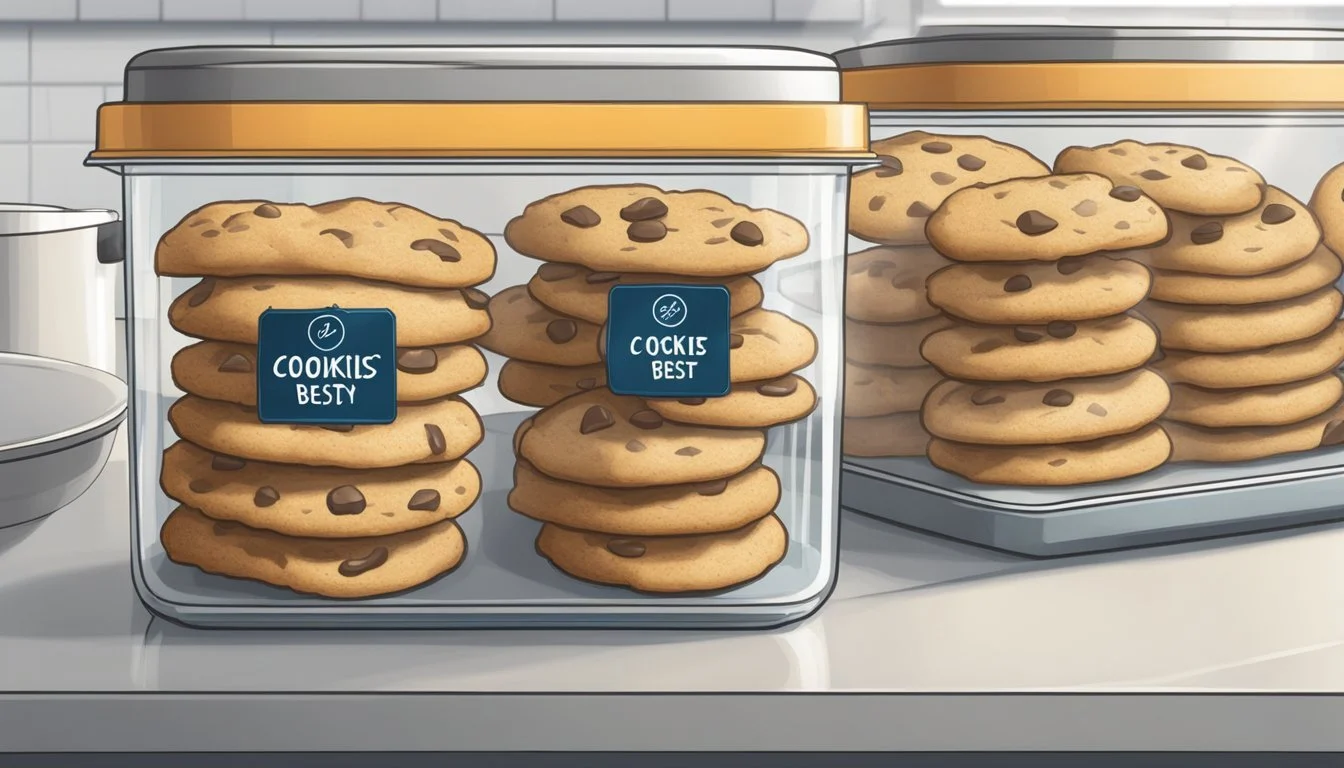How Long Do Gluten-Free Cookies Last?
Shelf Life and Storage Tips
The shelf life of gluten-free cookies can be quite different from traditional cookies, and understanding how to best store them ensures they remain fresh and enjoyable for as long as possible. In a closed container in a cool, dry place, gluten-free chocolate chip cookies typically last about 1 week. Proper storage is crucial since gluten-free varieties can dry out more quickly due to their unique ingredient composition.
For those who bake in larger batches or wish to preserve their cookies for an extended period, freezing might be an ideal solution. They can be stored in an airtight container or freezer bag, allowing them to maintain their delightful texture and taste for up to three months. Make sure the cookies are cooled completely before freezing to avoid moisture buildup.
Ultimately, the lasting appeal of gluten-free cookies hinges on how they are stored. Home bakers should pay close attention to their methods, ensuring each bite is as fresh as the day they were baked. With the right approach, enjoying these treats beyond their typical shelf life is entirely possible, offering more flexibility in how and when they are savored.
Understanding Gluten-Free Cookies
Gluten-free cookies rely on a unique set of ingredients and the science of gluten-free baking to produce a delicious product. Understanding these elements is vital to achieving the right texture and taste.
Ingredients and Their Roles
The ingredients in gluten-free cookies vary but often include gluten-free flour, butter, and sugar. Gluten-free flour consists of white starch type flour and occasionally wholegrain type flour. Flour blends may include rice flour, millet flour, tapioca flour, and potato starch.
Butter acts as a fat source, creating richness and aiding in binding the mixture. Sugar not only sweetens but helps in browning and creating a caramelized flavor. Xanthan gum is often added as a binder to mimic gluten's elasticity. Eggs provide structure and moisture, while vanilla extract enhances flavor. Baking soda and baking powder are essential leavening agents for achieving the right texture.
Gluten-Free Baking Science
Gluten-free baking requires understanding the absence of gluten and how it affects texture and structure. Gluten typically provides elasticity and chewiness in baked goods.
Without gluten, other ingredients must compensate. Xanthan gum and guar gum act as gluten substitutes by giving dough the necessary stretch and structure. Balancing wet and dry ingredients is critical, as gluten-free flours tend to absorb more liquid. Proper hydration is essential to avoid dense and dry cookies.
Temperature control during baking also plays a crucial role. Butter's consistency impacts the cookie's spread, and variations in oven heat can affect the final product's texture. Understanding these scientific principles allows bakers to create gluten-free cookies that don't compromise on quality.
Preparing Gluten-Free Cookie Dough
Proper preparation of gluten-free cookie dough involves specific techniques and attention to texture and consistency, as well as crucial resting and chilling steps to ensure the best results.
Mixing and Technique
When preparing gluten-free cookie dough, the mixing process is critical. Using a stand mixer with a paddle attachment helps blend the ingredients evenly. Begin by creaming softened butter with sugar until light and fluffy. This may take 2-3 minutes.
Gradually add eggs and vanilla extract, mixing thoroughly. It's important to sift and combine all dry ingredients, such as gluten-free flour, xanthan gum, baking soda, and salt, before adding them to the wet mixture. Mix on low speed until just combined to avoid overworking the dough.
Texture and Consistency
Achieving the right texture and consistency in gluten-free cookie dough is essential. The dough should be soft yet malleable, neither too wet nor too dry. If the dough feels too sticky, gradually add a bit more gluten-free flour. Conversely, if it's too crumbly, incorporate a small amount of liquid like milk or water.
The ideal dough will hold its shape when pressed and provide a smooth, uniform texture. Depending on the recipe, add-ins like chocolate chips, nuts, or spices can be gently folded in using a spatula to distribute evenly without affecting the dough's integrity.
Dough Resting and Chilling
Allowing gluten-free cookie dough to rest is a key step in the preparation process. After mixing, let the dough rest for about 30 minutes. This resting period enables the flour to absorb the liquids, resulting in a more stable structure. Once rested, the dough should be chilled to enhance its handling characteristics and improve final texture.
Chill the dough in the refrigerator for at least an hour or overnight, wrapped in plastic wrap or stored in an airtight container. Chilling helps develop flavors and makes the dough easier to scoop or shape. Use a cookie scoop for portioning, ensuring uniform sizes for even baking.
Baking Gluten-Free Cookies
When baking gluten-free cookies, it is important to consider your oven settings, use the right equipment, and recognize visual cues for doneness. These factors ensure a successful baking experience and cookies that are delicious and properly baked.
Oven Settings and Baking Times
Oven settings and baking times are crucial. Preheat the oven to the required temperature, typically around 350°F (175°C). Using an oven thermometer can help ensure accuracy, as ovens can often be off by a few degrees.
The baking time for gluten-free cookies generally ranges between 10 to 12 minutes. This can vary depending on the size and thickness of the cookies. It is essential to monitor the cookies closely during the last few minutes of baking to avoid over-baking.
Using the Right Equipment
Using the right equipment can impact the outcome of your gluten-free cookies. A high-quality baking sheet or cookie sheet is essential. Consider lining the baking sheet with parchment paper or a silicone baking mat to prevent sticking and ensure even baking.
A large balloon whisk can be useful for mixing dry ingredients thoroughly. Additionally, a cooling rack will help cookies cool evenly and prevent sogginess. Using standard measuring tools for dry and liquid ingredients can ensure precise measurements, important for gluten-free baking.
Visual Cues for Doneness
Recognizing visual cues for doneness is key. Gluten-free cookies often do not brown as much as traditional cookies. They should appear set and firm around the edges but may still be slightly pale on top.
Look for a slight golden color around the edges, and ensure they have a firm bottom. If the cookies are too soft when trying to remove them from the baking sheet, allow them to cool for a few minutes before transferring them to a cooling rack.
By paying attention to these details, you can achieve perfectly baked gluten-free cookies every time.
Storing Gluten-Free Cookies
Proper storage of gluten-free cookies can considerably extend their freshness and ensure they remain delicious and enjoyable. Considering the unique properties of gluten-free ingredients, different storage methods may be necessary.
Short-Term Storage Solutions
For short-term storage, gluten-free cookies should be stored in an airtight container to prevent them from drying out. After baking, allow the cookies to cool completely on a wire rack before placing them in the container. This helps to prevent moisture buildup, which can make cookies soggy.
Store the container at room temperature, ideally in a cool, dark place. Do not refrigerate gluten-free cookies as it can lead to a change in texture, making them harder and less enjoyable to eat. If stored correctly, gluten-free cookies can last up to one week at room temperature while maintaining their best flavor and texture.
Freezing and Long-Term Storage
For longer storage, freezing gluten-free cookies is an effective method. Place the cookies in a single layer on a baking sheet and freeze until solid. Once frozen, transfer the cookies to a freezer-safe airtight container or resealable plastic bag. Label the container with the date.
Frozen gluten-free cookies can last up to three months. When ready to eat, allow them to thaw at room temperature. For a slight crispness, reheat them in the oven for a few minutes. Freezing helps to maintain the cookies' texture and flavor over time, ensuring they remain enjoyable.
Maximizing Freshness and Texture
To maximize the freshness and texture of gluten-free cookies, consider placing a piece of bread or a sugar cube inside the airtight container. This can help maintain moisture levels without making the cookies soggy. Avoid storing different types of cookies together as they can transfer flavors or textures to each other.
Always make sure cookies are completely cool before sealing them in any container to prevent condensation. And, choose high-quality gluten-free ingredients as they can better retain moisture and flavor, ensuring your stored cookies taste just as good as when they were freshly baked.
By following these storage solutions, you can enjoy your gluten-free cookies at their best for longer periods. Proper storage can mean the difference between a tasty treat and an unappealing snack, making these steps essential for any gluten-free baker.
Common Challenges and Tips
When baking gluten-free cookies, one may encounter various issues with dough consistency, transitioning traditional recipes, and finding suitable ingredient substitutions. Here are methods to tackle these challenges, ensuring your gluten-free cookies turn out delicious and perfect every time.
Troubleshooting Dough Issues
Dough Consistency: Gluten-free dough can be tricky. If too crumbly, add a bit more binder such as xanthan gum or psyllium husk. For dough that's too wet, gradually mix in additional gluten-free flour until the desired consistency is achieved.
Temperature Adjustments: Chilling the dough for 30-45 minutes can help it firm up enough to handle and shape properly. Baking at lower temperatures while increasing cooking time can prevent cookies from becoming too mushy or gummy.
Oven Calibration: Periodically check your oven temperature. An inaccurate oven can lead to inconsistent results with texture and bake time. Using an oven thermometer can help ensure your cookies bake evenly.
Adapting Traditional Recipes
Flour Ratios: When converting traditional cookie recipes to gluten-free, using a mix of 40% whole grain flours and 60% white starches can yield better results. Testing different flour blends helps find the perfect balance for each recipe.
Binders and Textural Enhancers: Adding binders like xanthan gum can help mimic the texture provided by gluten. Eggs, flaxseeds, or chia seeds are useful in providing structure and moisture, making your cookies soft yet sturdy.
Moisture Levels: Gluten-free flours absorb liquid differently compared to wheat flour. Adjusting the amount of liquid ingredients or the number of eggs can prevent cookies from being too dry or falling apart.
Ingredient Substitutions and Variations
Dairy-Free Options: To make dairy-free gluten-free cookies, substitute butter with plant-based margarines or coconut oil. Ensure the chosen substitute has a similar fat content to maintain the cookie's structure and flavor.
Vegan Substitutions: Egg replacements like flaxseed meal mixed with water or commercial egg replacers can be used for vegan cookies. For sweeteners, opt for maple syrup or agave nectar to keep the recipe vegan-friendly.
Experimenting with Add-ins: Gluten-free chocolate chip cookies can be enhanced with dairy-free chocolate chunks, nuts, or dried fruits. Add a personal touch by experimenting with various flavors and mix-ins to create unique and tasty variations.
By following these tips, challenges in gluten-free cookie baking can be managed effectively, ensuring delicious results every time.
Health and Dietary Considerations
When considering how long gluten-free cookies last, it's essential to think about the health benefits and allergen-free options available with these treats. Specific dietary restrictions like gluten-free, vegan, and dairy-free diets can affect shelf life and storage.
Gluten-Free Diet Benefits
Adopting a gluten-free diet can provide significant health benefits, especially for individuals with celiac disease or gluten sensitivity. By avoiding gluten, individuals can prevent damage to the small intestine, promote better nutrient absorption, and reduce symptoms like bloating and fatigue.
For those without gluten-related disorders, gluten-free treats can still be a healthier option due to the avoidance of refined grains. These cookies may contain alternative flours such as almond or coconut, which can offer higher fiber content and better nutritional profiles compared to traditional wheat-based cookies.
Allergen-Free Options
Creating cookies that are gluten-free, vegan, and dairy-free addresses several common dietary restrictions, making them accessible to a broader audience. These options help cater to individuals with multiple food intolerances or allergies.
For example, using dairy-free butter and egg substitutes like flaxseeds in the cookie recipes ensures that those with lactose intolerance or egg allergies can safely enjoy them. Additionally, opting for nut-free flour alternatives is crucial for individuals with tree nut allergies.
Overall, allergen-free cookies that are also gluten-free can provide a safe and inclusive option for consumers with diverse dietary needs. This approach promotes mindful eating and supports the health and well-being of various individuals.
Exploring Gluten-Free Cookie Varieties
Gluten-free cookies can cater to various tastes, from classic chocolate chip to innovative flavor combinations. Each offers its own unique twist, ensuring that there's something for everyone to enjoy.
Chocolate Chip Cookies
Chocolate chip cookies are a staple in gluten-free baking, often sought after for their familiar and comforting flavor. To achieve the perfect texture, blends of rice flour, millet flour, and tapioca starch are commonly used.
It's crucial to balance the flour types to avoid a gritty feel. Adding xanthan gum helps mimic the elasticity of gluten, resulting in chewy cookies. The dough is usually chilled before baking to prevent excessive spreading.
Using quality chocolate chips ensures a rich flavor, and some recipes add an extra egg yolk for a softer texture. Baking at a precise temperature, like 350°F, ensures even cooking without burning the edges.
Unique Flavor Combinations
Gluten-free cookies can also feature creative flavor combinations that go beyond the traditional. Ingredients like almond flour and coconut flour introduce nutty and tropical notes. Incorporating mix-ins such as dried fruit, nuts, and spices can enhance the taste and texture.
Different flour bases allow for unique flavors. For instance, using teff or sorghum flour can give a malty or earthy taste. Recipes often experiment with natural sweeteners like maple syrup or honey, adding depth and complexity.
These cookies might include unexpected pairings like lemon and rosemary or chocolate and chili, providing a delightful surprise with each bite. Balancing these elements ensures that the flavors complement rather than overpower each other.








